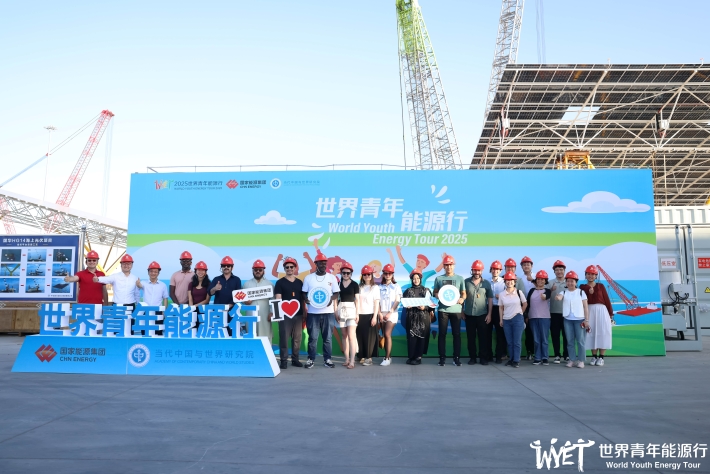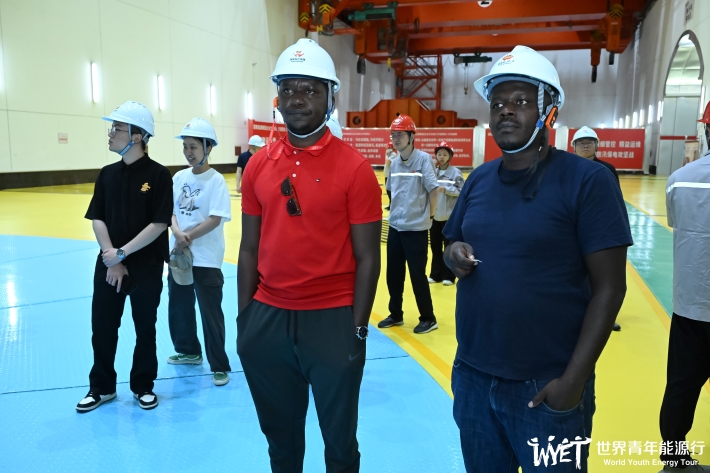|
||||||||||
| Home Top News Economy/Tech Culture/Sports China in Foreign Eyes Green Development Videos Intangible Cultural Heritages |
|
||||||||||
| Home Top News Economy/Tech Culture/Sports China in Foreign Eyes Green Development Videos Intangible Cultural Heritages |
| ChinAfrica |
| Clean Frontiers |
| From solar seas to smart hydropower, young global leaders explore China’s green energy transformation |
| By Li Yin | Web Exclusive ·2025-06-17 |

Young global leaders pose for a group photo at Guangli Port Assembly Terminal in Dongying, Shandong Province (COURTESY)
Donning safety helmets and life jackets, a group of young leaders and energy experts from around the world boarded a vessel early in the morning on 5 June. As the boat glided over glassy waters, the rising sun cast a golden sheen across the open sea, turning the horizon into a glowing canvas of light and colour.
In the distance, sleek rows of solar panels began to emerge, gleaming like a futuristic oasis rising from the sea. What awaited them was not only an engineering feat but a striking vision of the future unfolding on the ocean’s surface. It was the site of the HG14 Offshore Photovoltaic Project, a groundbreaking symbol of China’s renewable energy ambitions.
The HG14 project, currently the world’s largest open-sea floating solar farm, stands as a bold testament to China’s drive to integrate “blue energy” with a “green economy.” For these young delegates, it offered a rare, firsthand look at how China is tapping into marine resources through advanced technology, marrying sustainability with strategic innovation.
This visit was part of the World Youth Energy Tour organised by China Energy Investment Corp. (CHN Energy) and the Academy of Contemporary China and World Studies under China International Communications Group (CICG). The delegation comprised 14 international scholars and professionals from eight countries, many of whom hail from developing regions that share China’s challenges in achieving green development.
Offshore solar marvel
At the Guangli Port Assembly Terminal and the Guohua Investment Yuehai Photovoltaic Power Station in Shandong Province, the delegates got to see the technology driving China’s offshore solar expansion. From manufacturing and assembly to transportation, offshore installation, and grid connection, the group explored every stage of the process. The scale and precision of the operation left a lasting impression.
Experts detailed how the solar panels are specially engineered for marine conditions - built to withstand salty winds, corrosion, and rough weather. Designed with a 15-degree tilt and arranged in a special layout, the bifacial modules capture both direct sunlight and reflected light from the sea, increasing energy output by about 3 percent. These innovations are making offshore solar power generation not only viable, but highly efficient.
The visit showcased a wider transformation unfolding along China’s shores, where marine spaces are being harnessed for renewable energy development. For the young participants, it offered a fresh perspective: The coastlines are not just natural boundaries, but dynamic frontiers for green innovation and economic opportunity.
Innovation for efficiency
From the northern coastline of China, the delegation journeyed inland to the rugged mountains of Sichuan Province in the southwest. There, they visited the Daduhe Basin Production Command Centre and the expansive Pubugou Hydropower Station.
At this facility, traditional hydropower generation is revolutionised by cutting-edge technologies. Artificial intelligence, the Internet of Things, and big data are used to boost operational efficiency while ensuring environmental sustainability. Patrol robots conduct inspections, and the automated, often unmanned control rooms reflect a future where intelligent systems manage large-scale infrastructure with precision and minimal human intervention.
Steven Bihinda, a national energy and climate finance expert with the United Nations Industrial Development Organisation (UNIDO), described the experience as eye-opening. “This tour was very important to me,” he told ChinAfrica. “It introduced me to different innovations that enhanced both my understanding and capacity in the energy sector.”
Drawing on his experience managing hydropower projects in Rwanda, Bihinda commended the high standards of China’s construction work and the efficiency of its cascade management system, which coordinates multiple power plants from a single site using AI-driven controls - a model he believes could be adapted in Rwanda.
Many participants shared a similar sense of admiration for the scope and sophistication of what they saw. “I was truly amazed by the sheer magnitude and cutting-edge engineering,” said Jose Renato Peneluppi Jr. from Brazil. “These projects are not only engineering marvels, but also a powerful blend of innovation and long-term vision.”
On the final day of their trip, the participants returned to Beijing to attend the World Youth Energy Partnership Dialogue at CHN Energy’s headquarters, where they learned about the company’s extensive green energy portfolio.
At the seminar, CHN Energy spokesperson Huang Qing outlined a variety of innovative green energy initiatives underway across China. He emphasised that the country’s strategy is rooted in technological innovation while carefully balancing ecological protection with energy development. This approach reflects China’s core belief that “lucid waters and lush mountains are invaluable assets.”
Among the projects discussed were efforts to plant vegetation beneath solar panels to reduce wind erosion and stabilise soil, transforming deserts and arid lands into thriving energy hubs. Marine ranches combine offshore wind and solar platforms with aquaculture, maximising ocean resources in a multi-use model. Meanwhile, coal-fired power plants are evolving into integrated energy providers, supplying not just electricity, but also heating, steam for chemical industries, clean water, and waste heat for seawater desalination.
The seminar also provided a platform for youth leaders to share their insights and visions for the future of global energy. Their reflections revealed a deep commitment to addressing climate change, advancing sustainability, and ensuring equitable access to energy technologies worldwide.
Marc Manyifika, lead for Urban Resilience at the World Resources Institute, Africa, highlighted the gap between China’s achievements in technology, knowledge, and investment and what many African countries currently have. “International cooperation is critical,” he said. “It’s about building frameworks for exchange between China and Africa and fostering entrepreneurship by learning from China and adapting those lessons to meet our own challenges.”

Marc Manyifika (left) and Steven Bihinda (right) visit the Pubugou Hydropower Station on 6 June (COURTESY)
Youth power
Young professionals from diverse fields such as engineering, finance, and energy policy are emerging as key drivers in shaping the future energy landscape.
Tu Jianjun, president of Agora Energiewende’s China Region, expressed strong confidence in the potential of international youth. His message was simple but compelling: “Young people are the architects, not just the beneficiaries, of the energy transition.”
Tu emphasised the critical role these young experts play in advancing the clean energy agenda. “With their varied expertise, they are uniquely positioned to address the complex challenges of decarbonisation,” he said. “Initiatives like this tour show how cross-border collaboration can overcome geopolitical barriers. The energy transition demands nothing less.”
As the delegation wrapped up its tour, what resonated most was not only the advanced infrastructure or dazzling technology, but a deep sense of shared purpose. Across cultures and continents, young minds are rising to the challenge of building a greener, more inclusive world.
| About Us | Contact Us | Advertise with Us | Subscribe |
| Copyright Beijing Review All rights reserved 京ICP备08005356号-5 京公网安备110102005860号 |